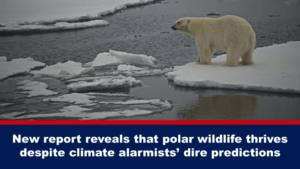New Report Reveals that Polar Wildlife Thrives Despite Climate Alarmists’ Dire Predictions
Sat 2:57 pm +00:00, 4 Mar 2023
The “climate emergency” narrative seems to be continuing down its path of self-destruct with a recent report by a prominent Canadian zoologist stating that polar bears and other polar wildlife continued to thrive in 2022 despite predictions of impending catastrophe.
In the ‘Polar Wildlife Report 2022’, published by the Global Warming Policy Foundation on International Polar Bear Day, Dr. Susan Crockford explained that ice-dependent species in the Arctic and Antarctic show no sign of impending population crashes due to lack of sea ice.
Overall, Arctic and Antarctic wildlife of all kinds appeared to be doing well, with very few exceptions. Polar bear, Atlantic walrus, and bowhead numbers in the Arctic continue to recover from overhunting, as do fin, humpback, blue, and southern right whale numbers in the Antarctic (although some more slowly than others).
The Polar Wildlife Report 2022, Susan Crockford, 27 February 2023, pg. 17
The reason why polar wildlife has been thriving, the report said, is that in both the Arctic and Antarctic less summer sea ice and increased primary productivity over the last two decades have meant more food for all animals.
So, it’s not just sun-deprived Britons who would benefit from warmer weather and more carbon dioxide. Nearly all wildlife, plant life and human life would enjoy a slight increase in temperature, even those used to the ice.
Dr. Susan Crockford is a zoologist with more than 40 years of experience. Her report is a peer-reviewed summary of the most recent information on polar animals, relative to historical records, based on a review of the 2022 scientific literature and media reports.
“There were no reports from either hemisphere in 2022 that would suggest polar wildlife is suffering as a result of reduced sea-ice extent: no starving polar bears or walrus, no beach-cast dead seals, no marked declines in great whale numbers, no drowned penguin chicks,” she said.
Polar bears are the apex predator of the Arctic. They currently have a relatively large population size and there has been no change in their historical range since 1979, despite what agenda-driven sources state.
The International Union for the Conservation of Nature (IUCN), in their 2015 Red List assessment, again listed the polar bear as “Vulnerable” to extinction, and in 2016, the US upheld its 2008 decision to list the species as “Threatened” under the US Endangered Species Act.17 Both decisions were based on computer-modelled future declines, not observed declines.
The Polar Wildlife Report 2022, Susan Crockford, 27 February 2023, pg. 3
Surveys estimate polar bear populations at 26,000 – 32,000, with a fairly wide margin of error. This is much more than the 7,493 bears the public was assured would be all that would remain given the sea-ice conditions since 2007.
The report noted that “contrary to expectations, while Arctic sea-ice extent has seen an overall decline since 1979, the trend has stalled: since 2007 for summer ice and about 2011 for winter ice.”
Summer ice, instead of declining further, flattened after 2007. Because of continued low summer sea-ice extent and reduced ice thickness – which allows beneficial under-ice phytoplankton blooms in summer – studies show primary productivity in many regions has continued to climb between 2003 and 2022, especially in the Barents and Chukchi/Bering Seas. These phytoplankton blooms provide abundant food for all organisms in the Arctic food chain including zooplankton (‘krill’), benthic invertebrates (such as clams), fish, and marine mammals.
Published data gathered from field studies on the bears’ physical and reproductive health provide irrefutable evidence from Barents and Chukchi Sea subpopulations, among others, that polar bears are fat and reproducing well despite marked declines in summer sea ice over the last two decades. These facts negate the premise that polar bears require abundant summer sea ice to flourish.
It’s not only predictions about Artic polar wildlife that climate alarmists have got wrong. Climate alarmists’ models incorrectly predict significant declines in Antarctic sea ice and, consequentially, penguin populations:
Antarctic sea-ice area has been surprisingly stable: overall winter ice cover has increased slightly since 1979. Perversely, climate models used to forecast future conditions (assumed to be driven by ever-increasing human-caused carbon dioxide emissions) predicted marked declines in Antarctic sea ice over the recent decades and even more over the 21st century.
Sea-ice experts have documented their concerns about [the] discrepancy between observations and model predictions for more than ten years; in 2022 a model proposed that virtually stable Antarctic winter sea-ice cover could be expected to continue to at least 2050, with only modest declines after that. However, this evidence has apparently been ignored by biologists proclaiming future declines in abundance of Antarctic species (especially krill, and several penguin species).
The Polar Wildlife Report 2022, Susan Crockford, 27 February 2023, pg. 16
Further reading:
- Climate Alarmists Left Shocked by Polar Wildlife Booming In 2022, The Great Climate Con, 28 February 2023
- For a detailed discussion of the status of all 19 subpopulations, see ‘State of the Polar Bear Report 2020’.
- Polar Wildlife Report reveals Arctic and Antarctic animals were thriving in 2022, Polar Bear Science, 27 February 2023













